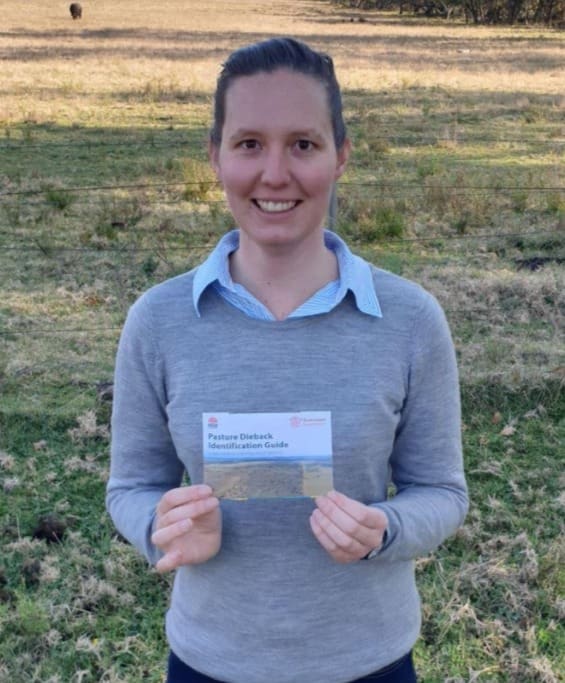
NSW DPI pasture systems development officer Sarah Baker with the new ute guide.
A UTE guide for pasture dieback and diseases has been released to help raise awareness of the condition that has killed sown and native summer growing pastures.
The Pasture dieback identification guide has been developed in partnership with the NSW Department of Primary Industries (DPI), Local Land Services (LLS), and Queensland Department of Agriculture and Fisheries (QDAF).
NSW DPI pasture systems development officer Sarah Baker said the new guide allows landholders to do a quick assessment and ascertain the likelihood of pasture dieback.
“The guide describes some common pasture disorders and diseases with symptoms similar to pasture dieback and covers environmental disorders and other nutrient and soil constraints,” Ms Baker said.
“Colour photos assist with identification and demonstrate the leaf discolouration that can vary between grass species ranging from yellowing, reddening or purpling.
“To date only summer growing grass species have been impacted by pasture dieback, with some grasses more susceptible than others. Legumes and other broadleaf species are not affected by the condition.
“Symptoms are most evident when grasses are actively growing during spring, summer and autumn, especially following significant rainfall. This is a good time to be checking pastures for signs of pasture dieback.
“Mealybug is associated with pasture dieback on the North Coast, but research to date indicates that pasture dieback is not caused by a single factor, but likely a complex interaction of multiple factors and environmental factors. Research is continuing.”
Landholders are encouraged to help us identify where pasture dieback is located. If you suspect symptoms of pasture dieback please:
- Contact the Exotic Plant Pest hotline on 1800 084 881
- Email [email protected] with a clear photo and your contact details or
- Complete the online reporting form
- Contact your nearest Local Land Services office 1300 795 299
North Coast LLS Senior Land Services Officer, Nathan Jennings said pasture dieback was first confirmed near Murwillumbah in March 2020 and has continued a slow and sporadic spread across the far north coast.
“After 12 months, some properties still have minimal to no grass, while others have shown partial recovery,” Mr Jennings said.
“We have confirmed pasture dieback as far south as Clunes and out past Kyogle around Sherwood and, it’s still spreading.
Although pasture dieback is known to occur in a region, it does not mean that every property will be affected.
Mr Jennings said pasture dieback doesn’t just affect our livestock producers. We have seen areas with no agricultural activity affected by pasture dieback and the loss of grass cover is leading to broadleaf weed invasion.
“There are some producers in the Tweed Valley that have lost more than 100 acres of pasture since March this year, so it’s important to identify it quickly and then develop a management plan and act on it,” he said.
“There are very few factors that can completely remove your ability to grow grass for livestock in a matter of a few months – pasture dieback is like a rapid drought in an otherwise perfect season.”
Download your free copy of the Pasture dieback identification guide from the NSW DPI website www.dpi.nsw.gov.au
This guide complements the comprehensive control and management guide for producers and agronomists released by Meat & Livestock Australia.

HAVE YOUR SAY